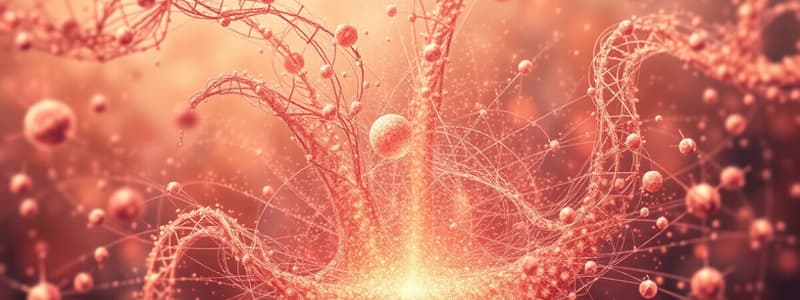Podcast
Questions and Answers
Which of the following is NOT one of the states of matter?
Which of the following is NOT one of the states of matter?
- Liquid
- Solid
- Plasma Wave (correct)
- Gas
Gases have a fixed shape and volume.
Gases have a fixed shape and volume.
False (B)
What theory explains the behavior of particles in different states of matter?
What theory explains the behavior of particles in different states of matter?
Kinetic Theory
In gases, an increase in temperature generally causes the pressure to ________, assuming volume remains constant.
In gases, an increase in temperature generally causes the pressure to ________, assuming volume remains constant.
Match each state of matter with its characteristic:
Match each state of matter with its characteristic:
What is the main factor that affects the pressure of a gas?
What is the main factor that affects the pressure of a gas?
Covalent bonds are formed by the transfer of electrons between atoms.
Covalent bonds are formed by the transfer of electrons between atoms.
What is the term used to describe substances made of two or more different types of atoms bonded together?
What is the term used to describe substances made of two or more different types of atoms bonded together?
Ions are charged particles that form when atoms either gain or lose ______.
Ions are charged particles that form when atoms either gain or lose ______.
Match the following chemistry concepts with their descriptions:
Match the following chemistry concepts with their descriptions:
Flashcards
Solid
Solid
The state of any substance where particles are closely packed, vibrate in fixed positions and have a definite shape and volume.
Liquid
Liquid
Particles that are found in liquids are close together but can move around, making them free-flowing. Liquids have a definite volume but no definite shape.
Gas
Gas
Gases have particles spaced far apart, moving freely and rapidly. They have no definite shape or volume and can easily be compressed.
Kinetic Theory
Kinetic Theory
Signup and view all the flashcards
Diffusion
Diffusion
Signup and view all the flashcards
Atomic Structure
Atomic Structure
Signup and view all the flashcards
Covalent Bond
Covalent Bond
Signup and view all the flashcards
Stoichiometry
Stoichiometry
Signup and view all the flashcards
Compound
Compound
Signup and view all the flashcards
Study Notes
States of Matter
- Matter exists in three states: solids, liquids, and gases
- The characteristics of each state are determined by the arrangement and movement of particles.
- Solids have a fixed shape and volume, liquids have a fixed volume but take the shape of their container, and gases have neither fixed shape nor volume.
Kinetic Theory
- The kinetic theory describes the behaviour of particles in matter.
- Particles in matter are constantly in motion.
- The energy of motion of particles increases with temperature.
- The strength of particle attraction varies between the different states, with particles in a gas having weaker attractions than particles in a solid.
States of Matter
- States of matter are defined by the arrangement and motion of particles.
- Solids -- particles are packed tightly in a regular arrangement, with limited motion
- Liquids -- particles are closer together than in gases but are able to move past one another
- Gases -- particles are spread out and move freely.
Pressure & Temperature in Gases
- Pressure is the force exerted by gas particles on the walls of their container.
- An increase in temperature leads to greater kinetic energy and an increase in pressure.
- Pressure and temperature are directly related; as one increases, so does the other.
Diffusion
- Diffusion is the movement of particles from an area of high concentration to an area of low concentration.
- This process occurs in all states of matter, but is most rapid in gases
- Diffusion can be affected by temperature; higher temperatures result in faster rates of diffusion.
Studying That Suits You
Use AI to generate personalized quizzes and flashcards to suit your learning preferences.




